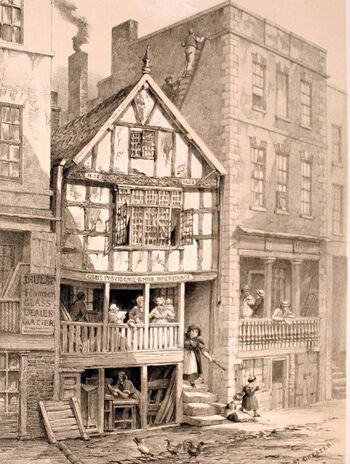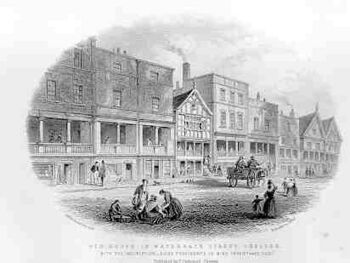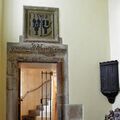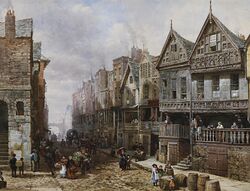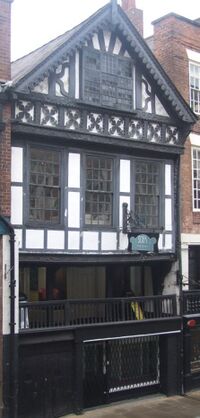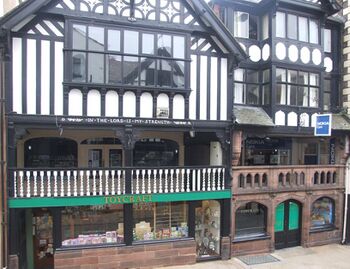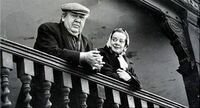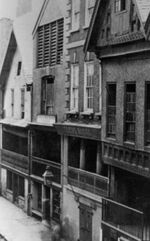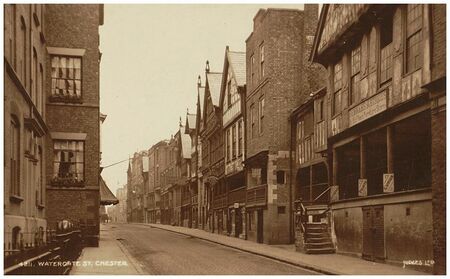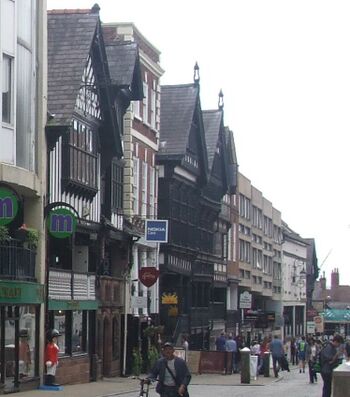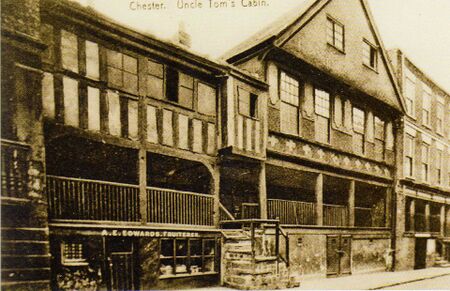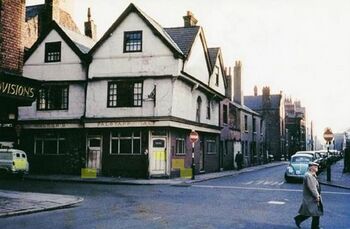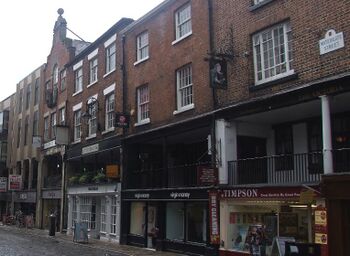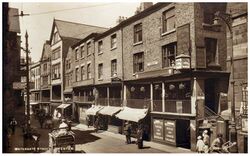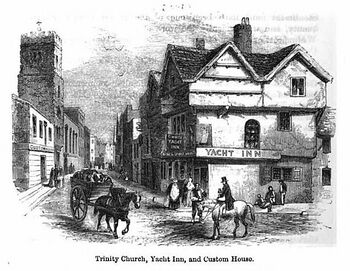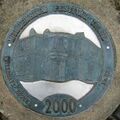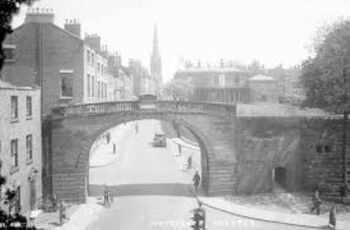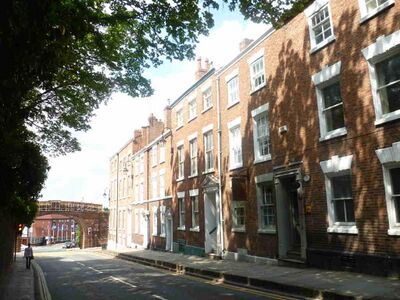Database changes have finished applying - please report any issues you're (still) seeing to support@shoutwiki.com.
Watergate Street
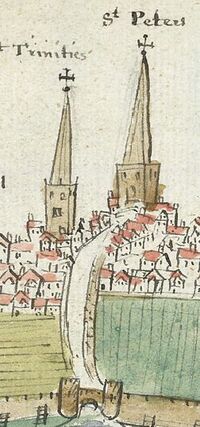
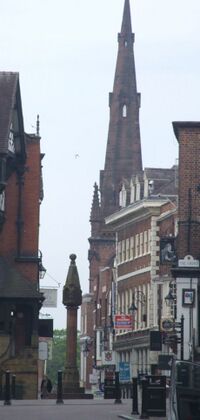
Watergate Street, along with Northgate Street, Bridge Street and Eastgate Street, is one of the four original streets built inside Roman Chester. All four streets meet at the High Cross, and each contains part of The Rows. In Roman Chester the street was probably wider and near the High Cross was lined with officers quarters with ordinary soldiers quarters behind them to the north. Just before the Roman west gate were the legionary granaries (horreae) on a plot between Watergate Street and Common-Hall Street, bounded to the west by Weaver Street and to the east by Old Hall Place. Apart from at the granaries the entire length of Watergate street would have been collonaded in Roman times.
Seacome, Batenham and Hemingway unashamedly copy each other in their descriptions of Watergate Street, so we leave it to Hughes to open this description:
- "Westward Ho! a few steps and we find ourselves moving along Watergate Street: once, and when Chester was a thriving port, the chief street of the city. As with men so "There is a tide in the affairs of streets, Which taken at the flood leads on to fortune" but the tide for Watergate Street has ebbed away and now flows in other and more favoured channels. Still, as we shall presently see this Street is not behind any of its neighbours in absorbing interest. You will perceive that like Eastgate Street it has the Cestrian characteristic on either side its high level Row. The one upon the right hand adjoining St Peter's Church is perhaps as good a specimen as we have now left to us of the Rows of the last century. Had we the time to spare a ramble along this Row and a hole and corner visit to the numerous alleys that intersect it would convince the most sceptical that there is more in Chester than meets the eye. But we must away for see here is an odd looking tenement on the other side of the street inviting our attention..."
The building to which he refers is discussed below. The "quote" from Shakespeare is Brutus (Julius Caesar: Act 4, scene 3) and is more correctly: "There is a tide in the affairs of men. Which, taken at the flood, leads on to fortune;"
Buildings (listed or otherwise)
The north side of Watergate Street was once the home of the city butchers and in the 16th Century was known as "Fleshener's" row.
Following the 1936 Housing Act the process of clearing the slums in the narrow "courts" behind the Watergate Rows began. Hundreds of people who lived there were dispossessed of their homes and moved to new housing at Lache.
By the 1960's Watergate Street was one of the sites in Chester which had become quite delapidated (the other with significant decay and dereliction being Lower Bridge Street). The City Council had been buying up property with the intention of restoring them, but did not have sufficient funds to even start repairs. The upper part of Watergate street is surprisingly narrow, but this does help disguise the few modern buildings that have crept in along The Rows over the years, particularly in the 1960's. Nikolaus Pevsner and Edward Hubbard, writing in the early 1970's, state that is "now the quietest and least commercialized of the main streets".
High Cross to St Martins Way (South)
Numbers 5-7
Numbers 5-7: are a pair of undercroft shops and a double row shop dated 1803. The undercroft at #5 has late Medieval rubble sandstone walling into which has been inserted a (probably 18thC) brick-barrel vault.
Number 9 ("God's Providence" House)
Number 9 is famous for the inscription on the Row fascia reading "God's Providence is mine Inheritance", said to be in thanks for deliverance from the plague of 1647-8. While the Civil War siege of Chester had been lifted with the surrender of the City on the 3rd Feb 1646, the effects of famine and other privations were such that in 1647 the plague broke out. From June 22nd until April 20th 1648 over two-thousand died of disease, over a third of the population, and at times all business was suspended.
- "The Plague takes them very strangely, strikes them black of one side, then they run mad, some drowne themselves, others would kill themselves, they dye within a few hours, some run up and downe the streets in their shirts to the great horror of those in the Citty" (Kennet, Loyal Chester)
This was a serious visitation of the pestilence and led to the following being recorded in the Journal of the House of Commons:
- "WHEREAS the City of Chester, and the Town of Warrington in the County of Lancaster, are grievously visited with the Plague of Pestilence; and that there are many very poor Persons in the said Places; which, if they be not relieved in an extraordinary Way, are like to perish for Want: It is therefore Ordered, by the Commons, assembled in Parliament, That, upon Wednesday the Thirtieth of this Instant June, being a Day of Humiliation, a publick Collection be made in all Churches, Places, and Chapels, within the Cities of London and Westminster, the Lines of Communication, and weekly Bills of Mortality: And that the one Moiety of the said Money that shall be collected be paid, by the Collectors thereof, unto Mr. Henry Ashurst and Mr. James Wainwright, Citizens of London, or their Agents, at the Sign of the Talbot in Cateaton Street, near Guildhall, London: Who are hereby required forthwith to send Two Parts of all such Monies as they shall receive unto the Mayor, Aldermen, and Sheriffs, of the City of Chester; and the other Third Part unto the Constable of the said Town of Warrington,.. "
It is worth noting that the house bearing the inscription was built in 1652 (the earlier building having been destroyed in the Civil War), by which time the plague was over, and so the inscription, if it does have anything to do with the plague, actually relates to the earlier (presumably seriously damaged) house on the same site. As for the origin of the quote: the motto "God's Providence is mine Inheritance" belongs, according to Burke's Peerage, to Richard Boyle, Earl of Cork, who rose from a poor background to become one of the richest men in England by the 1630's. This family is closely identified with Frome, Somerset, where a very similar inscription appears on a public fountain (the Boyle Cross). Boyle managed to achieve what seems now the extraordinary feat of gaining strong favour at various times with the leaders on either side of the English Civil War. Several people are known to have copied the motto, and it is recorded in several places, including upon at least one doorway lintel (dated 1625) at Ballygally Castle in County Antrim. As the inscription is frequently associated with the "settlement" of Ireland ("plantation" or "occupation" depending on which side you sit) it may be a political statement and nothing to do with the pestilence at all.
Hughes (1858) writes of the building:
- "Two hundred years ago that house was in the pride of youth and the residence of a family of some rank and standing as is evidenced by the armorial bearings carved on one of the beams, but as somebody or other (Longfellow we believe) has justly enough observed "it is not always May" in proof of which this house has of late years been occupied as a sausage shop and now shelters the defenceless head of a barber. Small and low are the rooms of this house absurdly so to the critic of the present generation and so contracted is the ceiling of the Row at this point that no man of ordinary stature can pass along without stooping. Is it not a quaint old spot! Look up at yon inscription on the cross beam. Tradition avers that this house was the only one in the city that escaped the plague which ravaged the city during the seventeenth century. In gratitude or that deliverance the owner of the house is said to have carved upon the front the words we are now reading - 1652 God's providence is mine inheritance 1652"
The property is believed to date from various period between the late 13thC and 1652, but was largely rebuilt by James Harrison in 1862. This was in the face of the owners wishes to demolish the house, something which was opposed by the Chester and North Wales Architectural, Archaeological and Historical Society. The battle to save God's Providence House is the first recorded conservation case in Chester. The future of this 17th century building was raised by none other than Thomas Hughes at a meeting of the Chester Archaeological Society in November 1861.
Hughes urged that its existing character and the old carved timbers of the front facade be preserved. His plea bore fruit, for by the Society's next meeting, the architect James Harrison had been appointed as architect and his plans for the property displayed. However, despite Harrison's claims that the front was to be kept and as much of the ancient character as possible retained, the house was completely rebuilt. Drawings of the earlier building show a somewhat lower building, slighly sagging and carried on plain timber posts. Harrison's 1862 rebuild is based on that of the 1652 building, but is somewhat higher, still extending to four storeys, but now much closer in height to the buildings on either side.
John Hewitt commented on the changes in 1887 Journal of the Chester Archaeological and Historic Society:
- "Watergate Street contains the most examples of older work, a richness due to the street not being sufficiently central, or convenient to be worthy of rebuilding, as was the case of other streets. The first building to notice is " God's Providence House," not so much for its well-known legend, nor its dated and inscribed beam, as for the unsatisfactory manner in which it has been restored. Reading of the admirable manner in which the owner had caused the building to be rebuilt upon the identical lines of the old work, a stranger would naturally expect to see the building an exact copy of the original, but in reality there is not one of the older features retained, saving of course the beam. Despite what has been said in favour of the new God's Providence House, the old one, with its simple but artistic and modest timbers, was much more interesting than the new, with its cast-irony-looking panels and ill-proportioned timbers."
So, apart from the oak beam bearing the inscription, which was was "straightened out" and replaced in its present position, the whole front is a reproduction.
The building features in the novel "God's Providence House: A Story of 1791" (1865) by Isabella Varley (later Mrs George Linnaeus Banks). She included the "plague" story and it stuck. Hughes, of course, was writing before Varley, but Varley did much more to promote the story even if she did not make it up. This book was reviewed by "The Spectator" at the time of its publication who described it as follows:
- "one of those bewildering tales in which the muddling together of bits of "history" with an immense amount of nonsense, as utterly improbable as a Chinese romance, spoils both the facts and the fiction."
The American travel writer John L. Stoddard wrote of the building:
- One of the houses surmounting these sidewalks has a more juvenile appearance than its neighbors, since it was reconstructed thirty years ago. Upon the sill, however, just above the corridor, I read the ancient inscription: "God's Providence is my inheritance." Is it possible that these words betray the owner's disappointment on coming into possession of this residence? Apparently he had more faith in Providence than in the value of the premises. I fancy that his sentiments must have been, "God only knows what I am going to realize from this property." A friend of mine, who had invested heavily in Western farm mortgages here turned his face to the wall and wiped away a tear. It is claimed, however, that this inscription denotes the owner's gratitude to Providence for having spared his dwelling during the ravages of the plague in Chester two hundred years ago.
Gallery
- God's Providence House on Wikipedia;
- God's Providence House on Pastscape;
- A carved oak panel showing the house;
Number 11
Number 11 has what is undoubtedly the best publicly accessible stone undercroft in Chester, with four bays of quadripartite vaulting divided by an arcade of three octagonal piers. It is well worth a visit and is presently a bar - "The Watergates Bar". At the front, the undercroft show encroachment onto the street of some 2.5m. While the central row of three octagonal pillars are said to show 15thC. mouldings, the projecting "bell" indicates a date of 1250-1290, indicating that tne vault was rebuilt at some time in the 15thC, but using original materials.
The symmetrical three-bay brick building which stands above the undercroft is dated 1744 in deeds, and at row level an inglenook with an oak bressumer indicates that the rear wing may have been built as a separate dwelling in the 17thC.
Number 13
Number 13 is a house dated 1771, rebuilt on the site of an earlier structure. The undercroft uses the probably medieval walls of numbers 11 and 15 and has an inserted, segmented, barrel brick vault. During alterations in 1986 a blocked stone stair was found against the western wall leading up to row level.
Ghost
A poltergeist is reputed to move brushes, cards, kettles and glass vases.
Number 15
Number 15 is Medieval, but was rebuilt from Row level upward, probably in 17thC, and refronted and rebuilt at rear mid 20thC. The undercroft walls are of coursed sandstone rubble, stepping in towards rear of east wall, with 4 corbels at one metre centres. The ceiling is spanned by oak joists on three massive 17thC chamfered beams. An oak post can be see in the later rear wall of brick. The undercroft gives access to those of Nos 17, 21 and 25.
Number 17 (The Leche House)
Number 17 is considered (by some) to be the best preserved "medieval" town house in Chester (it dates from after the end of the medieval period). Frank Simpson wrote (Journal of the Chester and North Wales Archaeological & Historic Society 1915) of it:
- This old house is situated in Watergate Street, nearly opposite Goss Street. Strange to say, it is, perhaps, the least known of all the old half-timbered houses in Chester, yet it contains some remains of its ancient grandeur, not at the present time to be seen elsewhere in the City. The half- timbered front may safely be included among the six best specimens of this old Cheshire style of architecture still remaining in the City, and in this case it has never undergone any modern restoration. It has always been described as the town house of the Leches of Garden (sic), near Chester, erected about 1570 ; but the architectural details of the building do not support this view.
That is not the only mystery about Leche House: the architecture of the house incorporates what appear to be references to Catherine of Aragon, but the time from which these date is not at all clear and the reason for them being present remains a puzzle. The house is now a shop but there is no problem visiting. A full decription of the points of interest can be found on the separate page on Leche House.
- Leche House on wikpedia;
- Leche House on Cheshire Now;
Number 21
Number 21 is an early 18thC building concealing an earlier building. The late C13 undercroft has coursed sandstone rubble walls and a quadripartite vault of 3 bays (each 4.2m square) with chamfered ribs on moulded corbels. The ribs have a very similar profile to those at number #11. Half of the front bay of the undercroft has been cut away to accommodate a deep stone-cut cellar and a self-contained shop. The main undercroft chamber has a brick floor and a later rear extension has walls of rougher sandstone rubble and a probably 17/18thC brick barrel-vault with a rear wall now lined with breeze-blocks.
Number 25
Number 25 is an early/mid 19thC rebuild from rows upwards, with a 4.4m wide, 27.1m deep undercroft of probably late medieval masonry of relatively poor quality and an inserted brick barrel vault at the rear.
Number 27-33 (Refuge House)
This over-scaled mid-20thC concrete and brick block required the total demolition of three Rows buildings and their undercrofts, two of which were substantial twin-gabled, timber framed houses of the late 16thC.
Number 35
Number 35 is possibly a refaced late medieval structure but was largely rebuilt internally from Row level up 1890 for Charles Brown, probably by TM Lockwood, leaving little trace of any earlier structure. The gable end is marked with a cartouche "CB1890". The bressumer over Row front has with shaped brackets and a slightly jettied fascia inscribed "IN THE LORD IS MY STRENGTH" (almost a quote from Psalm 28). The close-studded third storey has a projecting mullioned and transomed 7-light casement. The base and lower shaft of a Roman column stand in a sunken area behind the undercroft which can be visited down the alleyway.
It is unknown whether the inscription on the bressumer was there before Lockwood's rebuild and while variants on the quote are known as family mottos the exact quote does not seem to be used. The Journal of the C&NWAAHS mentions it in a 1942 article "A Cestrian Looks at Watergate Street", but gives no detail. Notably, Hughes does not mention it in his fairly detailed description of these buildings.
A photograph exists of Charles Laughton ("The Hunchback of Notre-Dame" - 1939) and his wife Elsa Lanchester ("The Bride of Frankenstein" - 1935) standing on the Rows hereabouts and looking down on Watergate Street.
Number 37 (St Ursula's)
Number 37 has an undercroft of five and a half bays. The first half bay is an encroachment on the street, the next 3 bays have oak beams, the rear 2 bays have a quadripartite vault. This latter vault is late 13thC or possibly earlier, with chamfered ribs. Towards the rear the vaulting sits somewhat clumsily in an irregular space. The rear doorway with a round, continuously chamfered arch suggests that it and the undercroft walls are late 12thC: if they are then they are the earliest features yet dated in the structure of Chester Row undercrofts. The the early masonry continues under the Row, but not under the stallboard. From Row level up the building is a rebuild of the 19thC structure with some 20thC alterations.
A notable feature of the building is the sandstone shopfront with the words "St Ursula's" over the central doorway. A 1948 conveyance (CR 38/175 29 Nov 1948) records a transfer of ownership from:
- "Louisa Phyllis Brown of 18 Curzon Park South, Chester, widow, Sylvia Nessie Brown of Chelsey Cottage, Jordans Beaconsfield, co. Bucks., spinster, Stephen Humphrey Brown of 18 Curzon Park, solicitor, and Francis Humphrey Brown of Whitegates, Curzon Park, to the Mayor, Aldermen and Citizens of Chester of a shop No. 37 Watergate Street South called St. Ursula's Cafe in the tenure of John Jones."
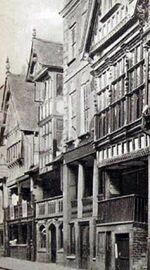
So it seems that the "St Ursula's" was a reference to a cafe which once occupied the crypt, and no connection can be established with Chester's "Hospital of St Ursula", a short-lived charitable institution founded in the early 16thC, and located in the vicinity of Commonhall Street.
Many people in Chester will recall this as the location of "Toycraft", a traditional "toyshop" which occupied the ground floor from 1965 until early in the 21st century.
- St Ursula's on Wikipedia;
- Conveyance to the Council (CR 38/175 29 Nov 1948);
- Hospital of St Ursula on British History Online;
Number 39
Number 39 retains most of its its 18thC fittings. The window-heads are almost identical to those at 11 Watergate Street.
Between this building and the next is a narrow covered alleyway leadinng to Weaver Street, at the far end of which in a lowered area is the base of a roman column.
Number 41 (Bishop Lloyd's House)
Number 41 is generally known as Bishop Lloyd's House. It bears a passing resemblance to 55 Bridge Street but whereas 55 Bridge Street is "Mock" (if not "Mockery") Tudor, some of the frontage of this building is original, although not without changes.
George Lloyd was born in 1560/1 in Denbighshire. He was educated at the King’s School, Chester and at Jesus College and Magdalene College, Cambridge, where he became a doctor of divinity. In 1594 Lloyd was elected to the divinity lectureship in Chester cathedral, and three years later became rector of Heswall, Cheshire. He became bishop of "Sodor and Man" in 1599, and then bishop of Chester in 1604. Attentive to his administrative duties and moderate with both Puritans and Roman Catholics, he was a skilful preacher, admired by Henry, Prince of Wales and Earl of Chester. Lloyd died in 1615 and was buried in Chester cathedral. George Lloyd's daughter Anne's first husband was Thomas Yale, whose son David was father of Elihu Yale, after whom Yale University in the USA was named. After Thomas Yale's death Anne married Theophilus Eaton.
Seacome writes of it as follows:

- "..an old house having the whole front divided into square compartments filled with carved work of various descriptions principally heraldry and scripture history. In the lowest line of compartments immediately over the Row are represented the following subjects: Adam and Eve standing on each side of the tree of knowledge the serpent twined round the trunk of the tree and over head a winged bust representing the Omnipotent issuing from the clouds, Cain killing Abel, Abraham offering up Isaac, Susannah and the Elders, A naked figure seated on a bed holding a sword in the right hand the point towards his side apparently in the act of committing suicide. There are three other compartments in the same line with those above described two of them consist of armorial bearings including amongst others the quarterings of the Principality of Wales and the Earldoms of Chester and Derby crested with a Bishop's Mitre the third bears an inscription illegible from the street and the date 1615. This house was built by Dr George Lloyd."
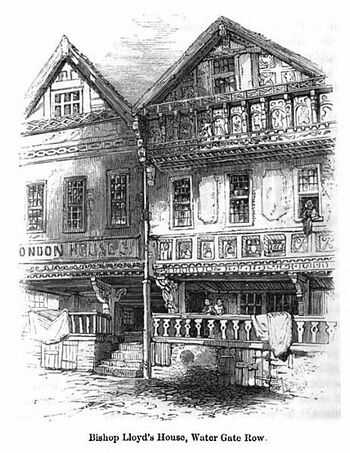
Hemingway describes the building thus:
- "Lower down on the same side is another very singularly decorated mansion the lower part of the front is divided into several compartments each having a sunk panel representing in rudely carved work some of the most noted events recorded in the scriptures such as the Serpent beguiling Eve the murder of Abel Susannah and the Elders &c &c In the two centre panels are the arms and initials supposed of Dr George Lloyd Bishop of Chester who died in 1615 which date is on the panel. The upper part of the house is also richly figured in the same paneled style nor is even the bottom neglected in the profusion of laborious handiwork for even the pillars and brackets which support the rows are carved in a ludicrous manner"
Hughes a little more detail, and gets quite carried away in religious fervor:
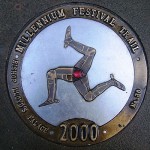
- "..exactly opposite to Crook Street stand three fine gable fronted houses the centre one of which deserves our attention and admiration. This house is without exception the most curious and remarkable of its kind in Chester and one which perhaps has no parallel in Great Britain. Prout has immortalised it in one of his inimitable sketches of which the accompanying woodcut is a reduced yet faithful copy. The origin of the house seems to be lost in fable but in the present day it is usually styled Bishop Lloyd's House from the fact of that Cestrian prelate dying about the date 1615 carved on one of the panels and from certain coats of arms arms which decorate the front bearing some analogy to the bearings of his family. Grotesquely carved from the apex of the gable to the very level of the Bow this house exhibits a profusion of ornament and an eccentricity of design unattempted in any structure of the kind within our knowledge. It is indeed a unique and magnificent work of art. To say nothing of the designs in the higher compartments it must suffice here to state that the subjects of the lower panels lay the plan of human redemption prominently before the eye. In the first panel we have Adam and Eve in Paradise in a state of sinless nudity then comes the first great consequence of the Fall Cain murdering Abel his brother. To this follows Abraham offering up his Son Isaac: typical of "the one great Sacrifice for us all". The seventh compartment has a curious representation of the Immaculate Conception whereby "Christ Jesus came into the world to save sinners". Ridiculous have been some of the attempts of "Local Guide-makers" to arrive at the real meaning of this design some have gravely set it down as the "Flight into Egypt" while another and later unfortunate has sapiently pronounced it to be "Susannah and the Elders". The eighth panel symbolises the completion of the great sacrifice the Crucifixion of Christ in Simeon's prophecy to the Virgin "Yea a sword shall pierce through thine own heart also". The three centre compartments contain the arms of the reigning monarch James I England's Solomon as he was called the supposed arms and quarterings of Bishop Lloyd and a Latin inscription with the date 1615. If it be true that "A thing of beauty is a joy for ever" then will this house as a masterpiece of art be an object of interest and delight to strangers till time itself shall be no more. We should step up into the Row at this point and scrutinise the indescribable forms of men and beasts which ornament and support the oaken pillars in front"
If the 1615 date on the panel is correct and represents the date that whatever building works had been done were completed, then Bishop Lloyd, who died that same year may have not lived here for long, if at all. In fact, there is no evidence that Bishop Lloyd or any of his family actually moved in and by 1616 Sir John and Lady Bowyer were known to have been living there.
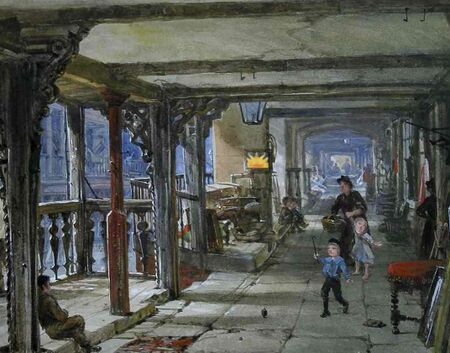
Gallery
- Bishop Lloyd’s Palace at Chester Civic Trust;
- Bishop Lloyd’s Palace at Cheshirenow;
- Bishop Lloyd’s Palace at Wikipedia;
- Bishop Lloyd’s Palace by ChesterTourist;
Number 51
Number 51 has fragments of the undercroft of a medieval town house. Rebuilt from Row level upward 1970s, the upper storeys approximately reflect the form of the house as rebuilt in the 17thC. Surviving parts of medieval squared sandstone rubble walls show that the undercroft was 5.3m wide - the west wall has 2 double corbels 1.15m apart with burn mark between.
It is possible that the "burn mark" is a remnant of a dreadful occurrence that the various writers of guidebooks describe in a similar manner. Hemingway writes of it as follows:
- "Further on is a passage called Puppet Show Entry from a melancholy circumstance which happened there on the 5th of November 1772. The upper part of the house was let to a showman who was exhibiting his puppets to a crowded audience when about 800lbs of gunpowder lying in a shopkeeper's store room underneath accidentally exploded and upwards of thirty persons were killed and the remainder about seventy were dreadfully burnt and bruised The whole city felt the shock as from an earthquake"
"Puppet-show Entry no longer exists, having been adsorbed into the structure of either the "New Age" shop (whose owner is expert on that membranophonic percussion instrument, the tabla) or the adjacent property.
While Hughes writes:
- "A few steps lower down the Row is a passage or alley communicating with Commonhall Street called Puppet Show Entry. This passage is chiefly memorable as the scene of a most terrific explosion which shook the city like an earthquake on the anniversary of the Gunpowder Plot November 5th 1772. A large room in this passage was fitted up as a sort of Marionette Theatre: a large audience had assembled the puppets were going through their strange evolutions when by some appalling misfortune eight hundred weight of gunpowder lodged in a warehouse below suddenly blew up with a tremendous report killing the showman and twenty two others - eighty three besides being more or less seriously injured. In remembrance of that fearful calamity this alley has been ever since known as the Puppet Show Entry."
At the time of the explosion Hemingway (also editor of the Chester Courant at the time) reported it as follows:
- "Some gentlemen repaired to the scene a few minutes after the accident, who gave particular directions that every person who showed the least signs of life should immediately be carried to the Infirmary where physicians and surgeons repaired to be ready to administer every possible means of relief. A clean bed was provided for every patient before the unfortunate sufferer could be stripped, which in general was by cutting off the clothes to prevent the agony of pulling those limbs which were broken, burned or bruised .. Some were employed entirely in bleeding all who required such an evacuation; others washed several times over all the burns and bruises with Goulard's cooling water; the rest were engaged in setting bones, etc. In these (they) were engaged from nine o'clock till four in the morning .. It happened that (all the sufferers were) of inferior station. But had they been persons of the most affluent fortunes and I carried to their own homes, none could possibly have received such immediate and effectual medical assistance as was administered to all, who were admitted to the Infirmary."
The most detailed description was given by John Bowden in his "The Explosion Or, an Alarming Providential Check to Immorality. a Poem. Occasioned by the Late Dreadful Explosion of Gunpowder, on the Fifth Day of November, 1772, in the City of Chester; ... by a Citizen of Chester. " (ISBN:9781170372975), of which an excellent account is to be found on "Chesterculture".
Number 53
Number 53 was rebuilt early to mid 18thC. Inside, access to the upper floors is by a very tight stair with a Chinese Chippendale balustrade.
Number 55-61
This block of four 1960's concrete shop units with flats above, actually was the winner of an architectural competition held by the then City Council (and judged by George Grenfell-Baines). It was designed by Bradshaw, Rowse and Harker of Liverpool. In the 1950's-60's this was a vacant lot which formed a notorious gap in The Rows - the Council had purchased the buildings on this site for restoration, but by the 1950's they had fallen into such a state of dilapidation that they were demolished as dangerous structures. The concrete "New Build" on this site may have been in keeping with its time, but rapidly became one of the issues that sparked a new debate about the best way to fit new buildings into Chester's historic streets.
Number 63-67
Number 61-63 has one section of medieval stone undercroft walling surviving, although a large chimney at rear west corner of No.63 is of 16/17thC origin. The facade is early 18thC restored early 1970s when all other parts were rebuilt. This is thought to have been the home of Henry Gee (once Mayor of Chester)
Number 69-71 (The Old Custom House)
Numbers 69-71 now a public house, comprises two undercrofts and town houses, now combined. The eastern house is dated 1637 on a much restored timber-framed gable amd also bears the initials "T & AW", thought to be Thomas and Anne Weaver after whom the adjoining Weaver Street is said to be named (prior to that it was St Alban's street). The row was enclosed in 1711, on the petition of Elanor Massie (noted as "Widow, of Dublin" in records entry AF/49d/14) for a 50s fine, but there is also a records entry (A/B/3/1.4.1714) that it was enclosed in 1714 by Bernard Fileding (innholder), again for a 50s fine. The former cottage on Weaver Street behind east-most house is of late Georgian Vernacular character and now forms a part of the public house. The plan of the licensed rooms is altered, but some oak beams survive and there is a carved stone fireplace with Classical surround of painted wood in the north east room.
Number 73
Number 73 has a brick front from c.1840, with no evidence of earlier fabric. The rear wing has no features of architectural interest, but is a rare survival a pair of courtyard dwellings which have avoided slum clearance.
Number 75
This is a poor quality half-timbered building from the early 20thC, with no surviving original material. The Rows her, like many in the immediate vicinity (69 Watergate Street down to the Yacht Inn) were enclosed in 1711. In this case the petition to enclose was granted to Thomas Alcott Smith, for a 50s fine (AF/49d/12).
The Yacht Inn
This stood, until the 1960's at the lower end of upper Watergate street, when it was demolished to make way for the inner ring road. Hughes, (apparently never one to pass a decent pub by) describes it as follows:
- "A good view of Trinity Church is obtained from the end of Nicholas Street just opposite to that ancient hostelry the Yacht Inn. The Yacht is without exception the most picturesque and curious of all our Chester inns. Time was when it was the first hotel of the city and even now grown grey with long and faithful service lacks nothing that can render it a fit home for the wayfarer whom chance or design has brought to the old city. Americans who lust after the ancient and venerable and who delight in the rare timber houses of old England will do well to select snug apartments at the Yacht for its host Mr White is the very impersonation of a true British Boniface. But the Yacht apart altogether from the qualities of mine host and his well filled cellar of Huxley's Fine has other claims upon our attention. It was at this house then in the zenith of its glory that the eccentric and witty Dean Swift (who has not read his Gulliver's Travels) stayed on one of his journeys into Ireland. The Dean being of a convivial turn invited the dignitaries of the Cathedral to a supper at the Yacht but to his great mortification not one of them appeared. Disgusted at this return to his hospitality the Dean scratched with his diamond ring on one of the windows of this house the following distich not over complimentary to the church or the city;- Rotten without and mouldering within: This place and its clergy are both near akin"
Unfortuately, when the pub was demolished in the 1960's to make way for the inner ring road, no-one thought to preserve what would now be an almost priceless piece of glass.
The Yacht gained further notoriety in 1879 when the landlady murdered her own children. As reported in the Wrexham Guardian (14th June 1879):
- "MURDER AND ATTEMPTED SUICIDE — A melancholy tragedy has occurred at Chester. On Friday night, Mrs. Miller, the wife of the landlord of the Yacht Inn, cut the throats of two of her children, and then attempted to take her own life. The injuries inflicted upon one of the children terminated fatally on Sunday morning, and the life of the other is despaired of. The unhappy woman herself is in a precarious state. There seems reason to believe that she is insane, aa for some time she has been in a despondent state, and had frequently been heard to deplore that she was not Ion,, for this world." An inquest has been held. Only one witness was examined, a stepsister of the deceased, who said her mother was a sober woman, bad nothing peculiar in her demeanour, and had not before the tragedy quarrelled with her husband. The unfortunate woman on Saturday night made another attempt on her life by tearing the bandages off her throat."
High Cross to St Martins Way (North)
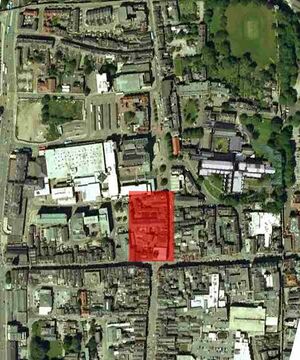
St Peter
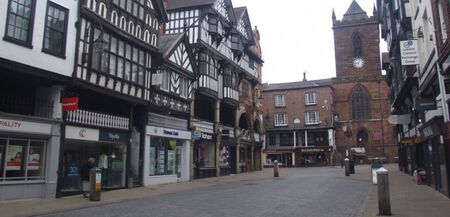
St Peter's church stands by the High Cross on the site of part of the Roman Praetorium and some of its fabric dates from that time. A church is said to have been built on this site by Ethelfleda in 907.
The present church dates from the 14th, 15th and 16th centuries, with modifications in the following three centuries. Formerly the tower had a spire which was removed and rebuilt in the 16th century, taken down in the 17th century, then rebuilt and finally removed "having been much injured by lightning" about 1780.
In 1849–50 the church was repaired by James Harrison, and 1886 it was restored by John Douglas, which included the addition of a pyramidal spire. On the northeast pier supporting the tower, just within the church door is a niche (which formerly contained a "Virgin and Child" statue), and surrounding it is the best preserved medieval wall painting in Cheshire (N.B. this should not be photographed using "flash", so as to prevent damage). There are other surviving medieval wall paintings at Chester Castle and St Johns.
sources and links
- St Peters own Parish website;
- St Peters at English Heritage;
- St Peters on Wikipedia;
- C o E site;
- ChesterTourist has some pictures and further information;
- St Peters on the National Pipe Organ Register
- Dove's Guide for Church Bell Ringers
Number 2-4 (Deva and Victoria)
The Victoria (previously the "Fox and Goose") has under-crofts whose structure is hidden save for a short length of sandstone rubble wall; the dimensions, 4.01 x 12.84m and 4.28 x 12.62m, suggest medieval origin. At Row level and above some elements of timber framing survive.
Number 6-8
Number 6-8 were substantially re-built during the 1970's and there is little of architectural interest.
Number 10
Number 10 is a timber-framed building behind an early 19thC. brick facade, with a Row-Level passage to the west. The undercroft is almost 9m wide and divided by a massive timber arcade carrying beams with four way bracing posts. Inside on the third storey there is a fireplace against the east wall which has a mantel on corbelled stone piers and a plaster over-mantel with the Royal arms flanked by the Corbett family arms surmounted by a frieze with sea-monsters similar to that in No.53 Row.
Number 12
A brick and concrete building of 1985. built in a sort-of neo-Vernacular style by Robin Clayton and Partners. This redevelopment involved the destruction of the early Medieval undercroft and timber framing of the previous building, with a dendrochronology date of 1207.
Number 14-20
A 1970's redevelopment in textured concrete and glass, by W Campbell and Son. The property at 14 Watergate Street came up for sale in 1900 when it was described as:
- LOT 1. The substantially-built and extensive SHOP, WAREHOUSES, and WORKSHOPS, being No. 14, Watergate-atreet and Watergate Row (North), and comprising large Shop, 100 feet 5 inches by 22 feet 9 inches, fitted with counters, shelves, and two offices, show-room in the Row, 91 feet 5 inches by 22 feet 9 inches, with large windows and glass doors the full width and height, show-room on second floor 100 feet 5 inches by 22 feet 9 inches, and a similar sized warehouse on third floor, the whoie fitted with shelves, &c., small yard on Row level, workshop, with tinnery hearth, 37 feet by 14 feet 9 inches new workshop, lighted from roof with forge, shelves, benches, c., 42 feet by 33 feet. The purchaser of Lot 1 can have the stock, remaining fittings and fixtures at a valuation, to be agreed upon between the parties. This lot has a frontage of 24 feet 4 inches to Watergate-street, and extends back 181 feet 4 inches and comprises an area of 600 square yards or thereabouts. lhe central position and extensive and com- modious character 01 the premises offer exceptional opportunity for investment. LOT 2. stable, loft, coach-house, and harness-room, with yard thereto, situate in and fronting to Goss-street. All the premises are in the occupation of Messrs. J. G. Shaw & Sons, ironmongers, &c., and vacant possession if required can be given on completion.
The facade of 18-20 is a rebuild in replica using modern brick, except that a cabin window from the 18thC. was not included in the rebuild due to the addition of a bridge over Goss Street.
Goss Street
Number 22
Number 22 is a mid 18thC. brick building which encloses an earlier house. The undercroft is probably 14thC., while the timber framing of the upper structure is 17thC. The western wall contains a medieval timber arcade which may have been a partition within a larger building, or, may be the only known non-masonry party wall between undercrofts on the rows.
Number 24
Number 24 has an undercroft (probably 14thC), which has been extended rearward in the 18thC., with the upper structure possibly of contemporary origin but altered 17thC. and refaced early 19thC. The undercroft is the same width internally as that at Number 22. There is evidence of a late medieval hall, behind a shop bay, at row level.
Number 26
Number 26 is a brick building of c1720, with a wider-than-usual undercroft having a pair of early 18thC., brick barrel vaults to the rear. At Row level and above the plan is double pile, with 2 main rooms at front and 2 at rear; there was no shop and the rooms fronting the row appear to be of a domestic rather than commercial character.
Number 28-34 (Booth Mansion)

Booth Mansion is the largest house in Watergate Street and was built in 1700 for George Booth of Dunham Massey (and, after 1694, 2nd Earl of Warrington) by remodeling two Medieval houses, one of which (to the east) was owned by Sir John Booth since around 1659. George is said to have moved in about 1678 (he was then aged about 2), and by the time he was in his early 20's the house was hosting lavish parties. His father, Henry Booth had been Chancellor of the Exchequer (1689-90) and became mayor of Chester in October 1691. His grandfather was he of The Booth Rising.
George inherited the earldom at the age of 19, and together with the earldom, appointment as the lord-lieutenant of Cheshire (although someone else was appointed to carry out that role until he was 21). George Booth inherited a debt-ridden estate and a house at Dunham Massey in poor condition (despite his father having been Chancellor). He dedicated his life to restoring the estate’s fortunes, marrying a wealthy merchant’s daughter for her dowry and building Dunham Massey as seen today in the 1730s.
Hemingway writes:
- Hamo the first Baron of Dunham Massey the time of Hugh Lupus held his barony from the of Chester by military service being bound to attend king in time of war with a certain number of horse foot and immediately to call out his whole posse if enemy's army should come into Cheshire or if castle should be besieged. Hamo the fifth baron Dunham died without male issue about the year 1341 having sold the reversion of Dunham and other to Oliver Ingham justice of Chester whose heirs for while possessed it but not without disturbance from Fittons. John Fitton married the elder sister and coheiress of the last baron of Dunham Massey the of Fitton married into the Venables family and the coheiress of William Venables of Bollin having Robert afterwards Sir Robert Booth - the claim was him renewed in the reign of Henry VI and it was at length agreed that Sir Robert should have one half of manors of Dunham Massey Altrincham and Hale. Sir Robert Booth was a younger branch of the Booths of Barton line and half brother of Lawrence Booth Archbishop of York. Having partly succeeded in claim he settled at Dunham Massey which by purchases became wholly vested in his descendants. George Booth the seventh in descent from Sir Robert was created a baronet in 1611 on the first institution that order his grandson of the same name with Baron Delamere of Dunham Massey at the of King Charles II, and Lord Delamere's son Henry the second Lord Delamere was created Earl of Warrington by King William. Mary, only daughter and of George Booth the second and last Earl of of that line who died in 1758, brought the barony Dunham Massey to Henry Grey Earl of Stamford grandfather of George Harry the present earl, who had of Warrington conferred on him by a new creation in 1796.
The design of the Watergate Street house differed from the new Lower Bridge Street houses which were being constructed at the same time (Park House - for example) in that it incorporated major elements of the two medieval houses on the site, radically altering their plan, increasing them in height and encasing the whole in a new brick elevation. The resulting house had an eight bay facade, with rusticated quoins and a heavily projecting wooden cornice below the hipped roof. The street level seems to have retained its shops, and six Tuscan columns were introduced at Row level to retain the Row level and carry the building above. In the undercroft is a medieval stone arcade and a wooden joist which has been dated by dendrochronology to 1260–80. Fourteen cores were taken from the joists over the eastern undercroft in Booth Mansion. There was sufficient cross-matching of five of the samples to permit the formation of a mean site chronology and this was compared with established chronologies to provide absolute dating for the last rings. This suggests that these joists were taken from trees felled during the second half of the thirteenth century. Other samples narrowed the dates of timbers in the western half to even earlier, from 1201 to 1231.
At the level of the Row, a 13th-century oak doorway remains from the medieval hall. The plan of the building has changed, but two large panelled saloons survive at Row + 1 level overlooking the street. This is an early example of the "double drawing-room", which appears on the first floor of Georgian town houses apparently for card parties and later for dances. Originally, this is where guests would have been received for tea or sherry before meals and ladies retired to after dinner to play on the piano nobile, play cards, admire artwork or engage in conversation. Booth wanted his house to be prominent from the High Cross and so the frontage is angled and encroaches into the street, for which Booth was "fined" £10 and charged an annual additional rent of £0.25. The current owners are still required to pay a token £1.00!
The staircase has notable, surviving cubic finials to the newel posts and "splat" balusters which have been carved to give the illusion of being turned. The top section of the 13thCent doorway is alongside the stairs. The 15th Century handrail to the stair was allegedly stripped off a sunken merchant vessel on the River Dee. A 12th Century stone corble survives on the Reception wall - it takes the form of a squating figure.
In 1702 Booth married Mary, daughter of Sir John Oldbury, a wealthy merchant in London. During the lady’s lifetime he published anonymously, in 1739, "Considerations upon the Institution of Marriage, with some thoughts concerning the force and obligation of the marriage contract, wherein is considered how far divorces may or may not be allowed, By a Gentleman. Humbly submitted to the judgment of the impartial." - an argument in favour of divorce on the ground of "incompatibility of temper" (which has never been a ground under English law). From other sources we can surmise that he had been convinced of the advisability of admitting this as a sufficient reason by his own unhappy experiences - he married for money, remember. Luttrell (Relation of State Affairs, v. 162) states that the lady had a fortune of £40,000l, and Philip Bliss, in a manuscript note in a copy of Walpole‘s ‘Royal and Noble Authors,’ now in the British Museum, adds:
- "Some few years after my lady had consign'd up her whole fortune to pay my lord’s debts, they quarrelled, and lived in the same house as absolute strangers to each other at bed and board."
Of the earl and his lady there is an amusing and (perhaps) not too flattering description in a letter by Mrs, Bradshaw to the witty (but quite deaf) courtesan Henrietta Howard (a mistress of King George II):
- "The Earl and Countess of Warrington, met us, which to me quite spoiled the feast; she is a limber dirty fool, and he the stiffest of all stiff things."
Booth's Earldom expired with his death in 1758. Unusually for the time, he wanted his only child, also Mary, to remain in complete control of her affairs and so he left Dunham in trust for her benefit (that way it would not become the property of her husband on marriage). She proved to be an astute manager, dealing with complicated issues such as the cutting of the Bridgewater Canal through the estate. She had married, in 1736 (aged 32), her much younger (aged 21) cousin Henry Grey, fourth earl of Stamford, who inherited the estates in Cheshire and Lancashire, and in whose son the title of Earl of Warrington was revived in l796.
Around 1745 the building became "Assembly Rooms" (the Lavaux Map shows Watergate Street and Goss Street as "Goose Lane" Booth Mansion is marked as the "Assembly House".) and the facilities were described as follows:
- Booth Mansion north of Watergate Street also accommodated assembly rooms, which as 'Mr. Eaton's Great Room' gave space in the 1750s for such diversions as "rope dancing, fire eating, and a learned dog". It closed in 1758.
At later times the building became the home of the Army Pensions Office, housed parts of the Court Service, and became (in 1883) the Liberal Club, after purchase for £2,500. Later it became a billiards hall, and later still, in WW2, the NAAFI. For a while it was home to Rudcock and Sharratt, the public analyst. After being derelict for some time it was restored and converted to an auction house for Sotheby's, and as of 2010, was offices. In it's most recent incarnation it is an art gallery and tea rooms (which closed in 2019).
Parts of the ground floor are occupied by "Turmeaus Tobacconist". Although there a a prominent sign stating "Est. 1817", Turmeaus acquired the well established cigar shop previously known as "Tobacco World" at 34 Watergate street, Chester in 2004. The Turmeaus family opened its first tobacconist shop in Liverpool in 1817 after their arrival from France. The Liverpool business is listed as becoming bankrupt in 1861. The same family appears to have been involved in the invention of the "Liverpool Lamp" once used as a back-up in some lighthouses and in early photography.
- Booth Mansion on Pastscape
- Booth Mansion at Wikipedia;
- Booth's Book about unhappy marriage;
- Dunham Massey at the National Trust;
- James Brotherhood restored it;
Number 36
A 20thC. brick building in a Georgian style, said to have been rebuilt following a fire. There is some surviving early evidence in the western stone wall of the undercroft which is shared with number #38.
Numbers 38-42
Numbers 38-42 has parts of the 14thC stone medieval town house at all levels, behind washed brick and rather weakly composed timber-framed facade. The exceptional width of the property (17.5m) allowed the stone walled former great hall to be placed along the row, parallel to the street and three service doorways between the screens passage and the hall survive. Dendrochronology of the braced ceiling joists of the east-most undercroft gives felling dates of the early 14thC. At some time in the late 16th century the great hall was divided (it was probably quite draughty) into four individually heated rooms.
Within the former great hall a large early 17thC chimney stack was inserted at Row level with back-to-back inglenooks. At the same time were inserted an intermediate floor with crossed chamfered oak beams, a timber-framed partition wall between Nos 32 & 34 and fireplaces on the third storey, to create four heated rooms. The 3rd storey fireplace at No.34 having a plaster overmantel with round panels between incorrect Ionic pilasters, and a ceiling with moulded plastered beams. There is a stair in each property thus formed, against the front wall of the former great hall.
This building may be the "Mansion Place" at the end of Gerrard's Lane, now Crook Street, mentioned at the time of Edward III. Being between the Lane and a vacant plot, this substantial medieval building would have contained an isolated section of Row. Due to its close proximity to Bishop Lloyd's House this building has been included in illustrations several times (including at least three by Raynor) and in all of those, as shown in the gallery above, the original stone frontage can be seen. The building was explored in some detail as the pilot study for the "Rows of Chester Research Project", an excellent report which provides much detail on the construction of the buildings forming The Rows.
Numbers 44-46
Numbers 44-46 have an enclosed Row level. Records (AF/49f/6) show that the Row was enclosed in 1713 on the application of Robert Bavand, a "Doctor of Physick", on payment of a fine of £2 10s. At the west a flight of 11 steps in a recessed porch leads to a door at former Row level. The undercroft contains a number of cross beams but all are re-used.
Numbers 48-50
Numbers 48-50 have an enclosed Row, and records (AF/49f/34) show that this occurred in 1713 upon the application of Sir Thomas Cotton, on payment of a fine of £2 10s. An earlier application for enclosure, made in 1701/2 by Robert Denteth, the previous owner, had been refused (although a contemporaneous application to enclose the Row at 54-56 had been granted). Part of a Tuscan pillar of the former Row front is visible in the west embrasure of the window on the former Row level. Like the adjacent building it has the high recessed porch which is characteristic of enclosed Rows. The third storey has a canted oriel with a 2-pane sash above a boarded cheek on each face, and with an ornate cast-iron cresting.
Number 52
Number 52 was wholly rebuilt in the early 20thC, and retains no early features. The Row of the earlier building was enclosed in 1713 on the application of John Martin, Yeoman, of Eastham, for a fine of £1 10s (AF/49f/7).
Numbers 54-56
Numbers 54-56 has its Row enclosed in 1701, following the application of a James Doe, who paid a fine of £5 and a yearly additional rent of £5. Elements of the structure, including the east wall of the undercroft (which may be truncated), date from c.1300. The upper part was rebuilt c.1840. It has the high porch and steps characteristic of an enclosed Row level.
Numbers 58-66
Numbers 58-66 are a terrace of five townhouses built in 1852 by Edward Hodkinson for Messrs Dixon and Myers, timber merchants. They replaced a 17thC timber-framed mansion belonging at one time to the Mainwarings. The 1816 print by Batenham shows this building, with a vestigial Row and a warehouse on the site of number 58. The undercrofts are brick barrel vaults.
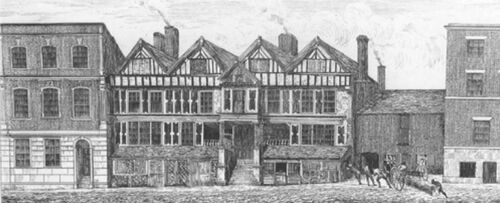
Hodkinson actually lived in Mainwaring House until its demolition in 1851. He was no fan of the half-timbered revival writing in the 1890 volume of the Journal of the Archaeological Society that:
- "It is much to be regretted that our fine old houses should not be restored in the spirit of their original design"
He then goes on to remark of the Old White Bear Inn in Lower Bridge Street - where a Georgian front had been painted in black and white to imitate timberwork:
- "...it is almost incredible that such a piece of vandalism should take place in Chester" (JCAS 1890, 324)
Number 68

Number 68 was rebuilt in 1789 for Alderman Henry Bennett and remained in the ownership of his descendants, the Heskeths, until the second half of the 19thC. The front elevation has been partially rebuilt and considerably altered in the mid 20thC, removing Ionic pilasters at first floor level. The Row was enclosed here in 1703 by a John Williams (no fine or rent was recorded). Of the three sash windows at the former Row level the centre one has a shouldered and eared architrave with a lion bearing a Cross of Lorraine on the face of a raised triple keystone, whereas the sash to each side has a painted stone sill and an acanthus keystone.
The following story is recorded of the house by Hemingway:
- About the year 1695 a Mr Joshua Horton came down from London occupied a large house in Watergate street at the corner of Trinity lane (afterwards rebuilt by Alderman Henry Bennet) leased the mansion called "Cotton Hook" for three lives and supported a handsome appearance in the city for some years. One evening, a great smoke penetrating to the house of his neighbour Alderman Mainwaring, an alarm of fire was given but the doors being kept closed and a great bustle perceived therein a curiosity was excited which ended in a threat of forcing the doors. Entrance being then given, half demolished furnaces and embers were found scattered over the cellars and a large pair of bellows the blast of which had forced the heat and smoke through two walls of stone and brick into the house adjacent. The coadjutors of Horton had escaped but a press for coining was found in a cistern in a yard and a bag of dies were found in the Dee next day which had been thrown in at high water. Mr Horton under these circumstance was committed to the Northgate and on Monday April 8 1700 Joseph Jekyll Esq chief justice came to the town hall and read a commission for trying him within the city after which he was convicted of knowingly having in his custody a press for coining and received sentence accordingly. A reprieve however was granted while some doubtful points were submitted to the judges and in this interval Mr Horton slipped through the gaoler's door mounted a good horse which was waiting in the Gorse Stacks and got to London where he lived and died in obscurity. On the 14th of September following Mr Jekyll came again to the town hall to inquire into the escape of which he acquitted the gaoler but fined the city sheriffs in the sum of one hundred marks
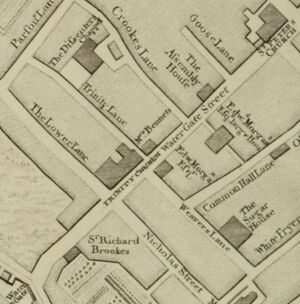
- Joseph Jekyll on Wikipedia - In his will he left £20,000 to help pay off the national debt, something Lord Mansfield described as: "a very foolish bequest.. he might as well have attempted to stop the middle arch of Blackfriar's Bridge with his wig";
Guildhall
The Guildhall occupies the redundant church of Holy Trinity which closed in 1960. The original building, which had a north aisle, dated from the 14th century. The east end and south side were rebuilt in 1680. This church had a spire which was rebuilt in the 1770s but in 1811 was considered unsafe and taken down. The present church was built between 1865 and 1869 to a design by James Harrison. He died before it was finished, and the church was completed by Kelly and Edwards. Like some other Chester churches, St Bridget's and St Michael's, it is located at the site of one of the gates of Roman Chester and the church buildings may have originally been a re-use of the gate buildings or materials. At the end of 2011 the City Guilds did not renew their lease on the property from the City Council and the management of the "Guildhall" passed to a local company.
Hughes describes it as follows:
- "Passing Trinity Street we arrive at the Parish Church of the Holy and Undivided Trinity the first foundation of which is lost in remote obscurity. So early as the year 1188 we find Walter, rector of this Church, witnessing a deed relating to the Church of Rostherne in this county. Very little if any of the original Church now exists;- the west side is perhaps the most ancient portion of the structure as it at present stands. Prior to 1811 the steeple was surmounted by a handsome spire which proving on examination to be in a dilapidated state was pulled down and the present square tower substituted. The reason for this change is not very obvious; perhaps there may have been bickerings and dissensions in the vestry as to the relative cost of the two and the authorities thought it best to give up the point in order to make matters square. The advowson of the Church is vested in the Earl of Derby, having previously belonged to the Norman barony of Montalt one of the titles created by Hugh Lupus, Earl of Chester."
Hemingway provides some further information:
- "Trinity church is situated on the north side of Watergate street; it is chiefly built of the red sand stone of the city; the north wall of the north aisle is cased with brick. In the early part of the 17th century the church was ornamented with a beautiful spire a representation of which is annexed from a drawing of one of the Randal Holmes From its exposed situation however and the perishable quality of the stone it required frequent reparation and in addition to these natural causes of decay the upper part suffered much in 1769 and 1770 from severe storms it is stated to have been three times re built within eight years. Early in the year 1811 some very serious apprehensions were entertained for the safety of the spire which had probably been rendered more sensitive from the fatal accident that had a little before happened to St Nicholas's spire at Liverpool by which a great number of people lost their lives. The late Thomas Harrison Esq was therefore employed to survey it and in consequence of his report it was taken down without the least accident. The stones which formed the summit of the spire, called the Rose,. were placed by Dr Thackeray in the Infirmary garden as a pedestal for a basaltic column from the Giant's Causeway. The east end and south of the church with the pillars and arches being in a ruinous state were rebuilt from the foundation in 1679. In 1771 the church yard was enlarged from land church yard enlarged ceded by the rector to the parish for which it was to pay him and his successors four pounds a year for ever. In 1774 the church was enlarged out of the churchyard fifty feet in length from St Patrick's aisle and twenty eight feet in width from south to north at an expense exceeding £500. In 1734 it was decreed that the four bells being cracked and broken should be re cast and two new ones added to the peal: in 1736 the new bells cast by Eudhall of Gloucester were placed in the steeple. The burying place adjoining to the church having been exceedingly crowded with bodies and inadequate to the use of the parish a fresh piece of ground north of the Linen hall and east of the city gaol was purchased in 1809 and consecrated September 22nd 1810 the total expense including the chapel railing &c was about £1000. The interior of this church is kept in remarkably good order every part of it presenting an appearance of beauty and cleanliness."
The summit of the spire did not stay at the Infirmary, it is now at the Countess Of Chester hospital.
The interior fittings of the church were removed when it was made redundant, but Hughes describes them as follows:
- "The interior is worthy the inspection of the curious. Near the south west entrance is the baptismal font by the side of which lies the defaced effigy of a mail clad knight, Sir John Whitmore by name, representative in the reign of Edward III of the Whitmores of Thurstaston a Cheshire family of knightly lineage and renown. This monument was discovered in 1853 under a pew at the southwest end; the face, hands, and knees having been barbarously cut away to suit the flooring of the pew. In its perfect state the monument must have been one of the purest symmetry and beauty and was evidently the work of an eminent sculptor the Westmacott or Gibson of his day"
Hughes continues:
- "A brass plate on the south side of the altar commemorates the burial of Matthew Henry June 22nd 1714. He who had during life been a rigid nonconformist "at the last sad scene of all" conformed to the faith of his forefathers and lies interred in the chancel of that parish in which he had so long ministered as a dissenter."
While in Chester, Matthew Henry founded the Presbyterian Chapel between Trinity Street and Crook Street (just back up Watergate Street from the Guildhall). He moved again in 1712 to Mare Street, Hackney. Two years later (22 June 1714), he died suddenly of apoplexy at the Queen's Aid House (41 High Street - then the house of the nonconformist minister, Joseph Mottershead) in Nantwich while on a journey from Chester to London. There is no evidence as to a "deathbed conversion" as implied by Hughes. In 1860 an obelisk designed by Thomas Harrison with a bronze medallion by Matthew Noble was erected in Chester to commemorate him. The obelisk originally stood in the churchyard of St Bridget's Church, and was moved in the 1960s to stand on a roundabout opposite the entrance to Chester Castle.
Hemingway gives a little more information about the monuments in the church:
- "In this church are many ancient sepulchral remains. Near the small eastern door is the monument of John Whitmore, Mayor of Chester in 1372 it was of white marble with a statue in armour bearing on the shield the family arms. Richard Cliffe Esq of Huxley who died 1592. Thomas Wooton, Mayor 1433. On the north side of the door before mentioned is a memorial of Henry Gee with this inscriptio: Here lieth the body of Henry Gee once Mayor of this City of Chester and in the same year he departed the xiii day of June Anno Domini mdxxxix whose soul hopeth for mercy. Several other members of the body corporate also lie in this church: William Massey Mayor 1590, William Johnson, Alderman Rowland Barnes 1596 etc. In this church are also the remains of Matthew Henry the celebrated Presbyterian divine on whose tablet to his memory is this inscription: Matthew Henry pictatis et ministerii officiis strenue perfunctus perlabores SS literis scrutandiset explicandis impenso confectum carpus huic dormitorio commisit 22 die Junii 1714 Anno aetat 52. Parnell, Archdeacon of Clogher and a celebrated poet was likewise interred here the 24th of October 1718."
- The Guildhall on Wikipedia;
Number 70 (Custom House)

The Custom House is described by Batenham as follows:
- "At the corner of thin street is the Custom House. The stranger will probably smile on discovering the humble edifice dignified by the title of Custom House but let him remember he is not in a commercial city nor where the splendour of modern taste is required to embellish its public buildings therefore any innovation would break the general effect besides which economy and convenience are very properly studied & for as the trade of the city is very limited the present little offices and warehouses are quite adequate to the duties required."
There has been a Customs House on this site since at least 1675 as in that year Sir Peter Pindar, identified as "Collector of Customs" applied to enclose the Row and was granted his petition on an annual rent of 3s. This was one of the earliest enclosures of the Rows, the first being that at the Falcon in 1643.
The Custom House as seen today (now home to a series of restaurants and at least one pub) was re-built in 1868, having been designed by James Harrison but completed after his death by Edwards and Kelly. The replaced door has an arched stone overlight of a quatrefoil between two smaller ones with the inscription "THE OLD CUSTOM HOUSE BLDG" across the lintel.
The Inner Ring Road
This was constructed in the 1960s to divert traffic from through the city centre, although the through-traffic function of the road was superseded in 1976 by the construction of Chester's southerly by-pass. Work involved demolishing a large tract of properties through Nicholas Street and Watergate Street (as well as elsewhere). A full history of the ring-road and an excellent gallery of pictures is to be found on ChesterWalls.info.
However, controversy about this road goes back further than the 1960's. Hughes writes as follows:
- "Returning to Watergate Street we see before us Linen Hall Street called formerly Lower Lane from its being at one time the last street on this side of the city. There is nothing to interest us in this street which terminates with St Martin's in the Fields at the rear of the Gaol and General Infirmary. So late as the sixteenth century there was at the further end of this street an ancient Church quoted in old deeds as the Church of St Chad but the place thereof is now nowhere to be found."
Hemingway (writing in 1831) is even more disparaging:
- "A little higher in the street is Lower lane a miserable receptacle of vice chiefly inhabited by the lowest order of people. At the corner of this street stands his Majesty's Custom house which though a building of small dimensions and miserable appearance is quite sufficient for the limited business of the port "
The Chester Chronicle (edited by Hemingway) is also pretty disparaging about the area:
- 24 September 1830 - Chester Police - DARING STREET ROBBERY - Ann Collinge alias McBride and Mary Pugh, two street walkers, were charged with stealing a parcel containing a pair of shoes from the person of Humphrey Foulkes of Kelsterton, boatman, at two o'clock yesterday. Foulkes stated that he was passing down Linen Hall Street, pushing at the back of a truck; and when he came opposite to Suderick (a noted haunt for prostitutes), he lost the parcel, but he could not tell who took it. Two females who witnessed the transaction said they saw Collinge and Pugh go behind Foulkes and steal the parcel out of his pocket, and run away with it. Information was given to Mr Dawson of the robbery, who apprehended the ladies in Watergate Street a short time afterwards, and found the shoes in the possession of one of them. As some essential witnesses were absent, they were committed to the House of Correction for further examination. It was stated by the officers that this abominable haunt is full of prostitutes, and that almost every individual who had been foolish enough to venture into it, during the last three months, had been robbed.
Lower lane has long gone and it is now "St Martins Way", although in 2002 a public inquiry rejected planning consent for a "massage parlour" in the Cromwell Court Hotel at 5 St Martins Way.
The inner ring road lies just outside of the line of the walls of Roman Chester along St Martins Way, and the original Roman gateway at the western end of the principal street would have stood here.
St Martins Way to Watergate (South)
Stanley Palace


Hughes describes it as follows:
- "..up a narrow inconvenient passage is a house which invites and eminently deserves our notice and admiration. This house is styled indifferently the OLD PALACE and STANLEY HOUSE from its having been originally the city palace or residence of the Stanleys of Alderley, a family of note in the county and now ennobled. This is an elaborately carved three gabled house and is perhaps the oldest unmutilated specimen of a timber house remaining in the city the date of its erection being carved on the front 1591. The sombre dignity of its exterior pervades also the internal construction of this house;- the large rooms the panelled walls the oaken floors, the massive staircase, all pointing it out as the abode of aristocracy in the olden time."
Hughes describes the house as having three gables because the forth, that nearest the street, was only added well after his time.
Stanley Palace was built in 1591 for lawyer Sir Peter Warburton of Grafton, Vice Chancellor of the Cheshire Exchequer and then the city's MP (and also - a relation to the bread bakers). When Warburton died in 1621, the property was inherited by his grandson. His (sixth) daughter; Elizabeth, was married to Sir Thomas Stanley, a kinsman of the earls of Derby (hence it is also known as Derby House). On the death of her husband Elizabeth married Sir Richard Grosvenor of Eaton Hall, she died in 1627 at "her Blackfriars home" (probably Stanley Palace) & was buried with the Grosvenors' at Eccleston.
The Stanleys were one of Chester's most influential families. Through their connection with the earls of Derby, they held custody of the nearby Watergate. Stanley Palace stands on the site previously between the Friary's of the Blackfriars and the Greyfriars. Thomas Stanley the first earl of Derby, managed to remain in favour with successive kings throughout the Wars of the Roses until his death in 1504. His estates included what is now Tatton Park in Cheshire, Lathom House in Lancashire, and Derby House in the City of London, now the site of the College of Arms. At Bosworth Field (1485) Thomas, Lord Stanley (he was the stepfather of Henry Tudor) and Sir William Stanley brought a force to the battlefield, but held back while they decided which side it would be more advantageous to support. A night shortly before the battle, asleep in the Blue Boar Tavern, King Richard was supposed to have had a terrible dream in which he was forewarned that all was lost. It is an unlikely story – one of many told about the King. More probable is the story that the Duke of Norfolk was warned cryptically of the Stanley brothers’ coming treachery by a notice pinned on the door of his tent while he slept. This read:
- "Jacky of Norfolk, be not too bold, For Dickon thy master is bought and sold."
When Richard III saw the treachery unfolding he was urged to flee, but flatly refused: “This day I will die as a King, or win” he is reported to have stated. Spying Henry Tudor with only a few men around him, Richard III gambled everything on personally leading a charge across the battlefield to kill Henry Tudor and end the fight - Richard almost succeeded. However, seeing the king's knights separated from his army - perhaps not more than 100 in all - and open to attack, the Stanleys intervened; Sir William led his men to Henry's aid, surrounding and killing Richard. Richard III's last words were apparently "Treason! Treason! Treason!". After the battle, Richard's circlet was found and brought to Henry Tudor, who was crowned king at the top of Crown Hill, near the village of Stoke Golding.
A later William Stanley is sometimes said to have written (between 1589 and 1613) the plays attributed to William Shakespeare. His brother Ferdinando, also known as Lord Strange and who was to become the fifth Earl of Derby, formed his own group of players known as Lord Strange's Men. Lord Strange's Men was one of the leading companies of the time, by 1592, probably including a little-known actor named "William Shakspur" from Stratford-on-Avon. Eventually, Lord Strange's Men became The Chamberlain's Men and finally The King's Men.
- Stanley Palace - official site (many pictures);
- Stanley Palace on Wikipedia;
- Stanley Palace at English Heritage;
Number 93
Number 93 is a mid 18thC town house with the main front to Nicholas Street mews.
Watergate House
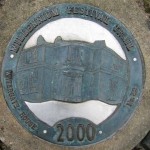
Watergate House was built in 1820 as a town house for Henry Potts, Clerk of the Peace for the County of Cheshire. It was designed by Thomas Harrison. In 1907 it became the headquarters of Western Command. It then became the headquarters of the Cheshire Community Council, and has since been used as offices. The plan is probably unique. The entrance leads through a domed circular corner lobby to the octagonal central hall with a pair of pillars, west, supporting a gallery-landing. The stone main stair south has moulded iron balusters. Conversion to offices has left structure and detail largely undamaged, most notably the west range of rooms.
Hughes writes of this building:
- "..on the left is the handsome city residence of H Potts Esq representative of a family long and honourably connected with the county. This house and the locality round occupy the site of the ancient Monastery of the Black Friars where the black cowled faithful fasted and prayed down to the period of the Dissolution but of which scarcely any traces save the fragment of a wall are now discernible."
Henry Potts was Clerk of the Peace for the County of Chester and a principal in the legal firm of Widden, Potts and Leek which had been established in Chester since 1779. The Potts family had a country estate at Glan-yr-Afon, Denbighshire (also built by Harrison), and produced one of the firsts riders to win the "Grand National" (on "The Duke"). Arthur Potts, second son of Henry was a noted railway engineer and lived at Hoole Hall. Eliza Potts (1809-1873), daughter of Henry Potts, was a noted botanist, whose studies have done much to record and understand wild plants in Cheshire and North Wales. Eliza spent her summers at the family’s country house where she collected and studied plants. She also collected from other sites in North Wales, and her collection (now housed in the Grosvenor Museum) contains many first or early records of plants from this area. She contributed to T.B. Hall’s "A Flora of Liverpool" (1838), with "Thirty Interesting Cheshire Plants of Parkgate and Hoylake". Lord de Tabley referred to her in "The Flora of Cheshire" (1899) saying, "She stands pre-eminently as the best lady botanist whose records are included in the present flora". In 2019 her portrait by William Owen Harling (1813-1879) was purchased by the Grosvenor Museum.
The obituary of Edgar Garston - from his obituary Chester Courant 29 October 1873 states:
- "The deceased gentleman was born and educated in Chester, his family carrying on the business of Wool merchants in Pepper Street, the premises now known as Caxton Buildings, and residing at Watergate House, the present residence of Mr Green."
This presents something of a mystery as Garston was born in 1800.
This was also the location of "Black Hall" (probably named after the nearby Blackfriars). This is marked on some old Maps and on the Lavaux Map as "Sir Richard Brookes" house. The Brookes appear to have owned the property from 1702 to around 1820. The first Baronet Brooke of this line was a colonel in the parliamentary army and in 1644 made High Sheriff of Cheshire, a post he held for four years. In 1659 he joined others of the Presbyterian gentry to support George Booth in The Booth Rising, an attempt at restoring the monarchy. He was imprisoned in Chester Castle but with the coming of the Restoration he was released and created a baronet by Charles II in 1662. Subsequent generations named their first son Richard. As Lavaux is mapping in 1745, his Sir Richard is probably the 4thBt. The Brooke line had their main home at Norton Priory (demolished 1928), now a major archaeological site near Runcorn. Nicholas Street Mews was formerly known as "Brooke Street".
- Watergate House at English Heritage;
- Watergate House on Wikipedia;
- The owners website (a broken link);
- Potts Manuscripts in "Archives Wales"
St Martins Way to Watergate (North)
Every building on the north side of Lower Watergate Street is listed, and comprise a terrace known as the "Watergate Flags", of which construction started around 1779 (with involvement of Joseph Turner). At that time remains of the Roman baths were found, and Broster, writing for publication shortly afterwards, in 1781, gives the following account:
- "In the lower Part of the Field where the Hall is built in the Year 1779 in digging Foundations for a Row of Houses adjoining to the Watergate were discovered very little below the Surface the Remains of a Roman Hypocaust and Sudatory buried in their own Ruins besides which was Part of a tesserated Pavement and an elegant Roman Altar dedicated to the God Aescluapius by a Standard Bearer of the Legio Augusta or Second Legion The Inscripsion is rendered imperfect by the Violence used in getting it up. The Hypocaust consisted of the same Number of like formed Pillars to those which are to be seen near the Feathers Inn. The Sudatory stood lower down much nearer the Gate, the upper Floor of which was supported by Twenty four Pillars composed of Tiles nine Inches square and two Inches thick filled up with a fine red Clay on the Top of each Pillar was placed a Tile of two Feet square which seemed to have supported a double Floor of coarse Cement round the Sides of the Room there appeared to have been a Row of Tunnel Bricks like those found a few Years ago at Wroxeter fixed with their upper Ends level with the Surface of the Floor each Tunnel having two opposite Mortice Holes or a cross Passage to convey the Heat more regular over the Sweating Room. Its Pavement run in a circular Mosaic Figure the Tesserae of which it was composed were of three different Colours viz A dusky Blue a Brick Colour Red and a yellowish White of Cubes not exceeding half an Inch. The precipitate Rashness of the Owner in disturbing the Materials prevented many Persons from making proper Designs from the whole as was most ardently wished for the future Speculation of the Curious. Amongst the Ruins were found several Tiles with LEG XX VV slamped on them, some few Coins of the Emperors Hadrian and Trajan, also Horns and Instruments of Sacrifice."
Ghost
Number 102 experiences bumps, rattlings and cold draughts. It has been said that nobody will live there. Back in 1937, the building housed the drawing offices of the Chief Engineer for the army's Western Command. Staff were used to hearing inexplicable noises. But when two colleagues working late one night heard a long, drawn out rattling followed by a loud crash coming from a first floor room, their hair stood on end. A careful search, however, revealed nothing. Several months later, a man dropped in unannounced to show his wife the “haunted house”. Staff were surprised when he told them he had been billeted there during World War I. Even then, he said, strange noises had come from the first floor room at the front. A horrible death of the sort associated with hauntings may have occurred hereabouts, as reported in the Wrexham Guardian (24th August 1878):
- "THE RESULT OF DRUNKENNESS — An request was held at the Infirmary on Monday afternoon, on the bodv of an old woman, named Bridget M'Ardle, who was so shockingly burned on Saturday morning in a house in Watergate-street, that she died during the same day in the Infirmary, where she was removed to. The evidence showed that the deceased, who resided with her daughter and son-in-law, had been drinking with her daughter during the whole of Friday, and the husband, whose name is Icke, was so annoyed that he went on the spree also. He returned to the house after midnight, and found his wife on the floor dead drunk, and with an infant in her arms, and her mother in flames in a chair by the fire. By the time the fire was put out by some of the neighbours who were called in, the deceased was very badly burned. Mrs Icke admitted she was so drunk that she did not know what happened, and Icke said he was in drink and mad, but was not drunk. The deceased, who was in the habit of smoking, was very drunk, and it is supposed that in lighting her pipe she set fire to herself, and was too drunk to extinguish it. The coroner commented in strong terms on the conduct of the Ickes, and the jury, in the absence of any other evidence, found that the deceased was accidentally burned to death."
Related pages
Connects
Sources and Links
- Watergate Street by ChesterTourist;
- Watergate Street on 192.com;
- WATERGATE STREET: AN INTERIM REPORT OF THE CHESTER ROWS RESEARCH PROJECT;


